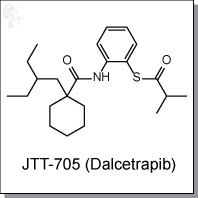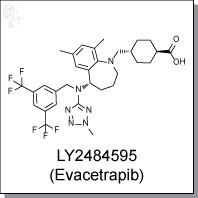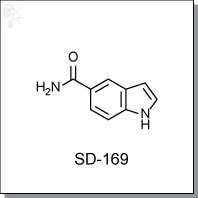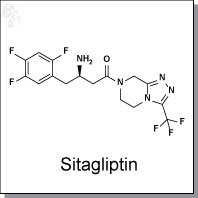|
Disease Area, Cardiovascular & Metabolic IV
Product Name: JTT-705 (Dalcetrapib) | CETP inhibitor
|

|
|
Dalcetrapib (JTT-705) is a CETP inhibitor of the thioaniline family with a potency of 0.2 uM aimed at raising
HDL cholesterol levels. It also inhibits CETP-mediated transfer of CE from HDL to apoB-containing
lipoproteins in human plasma at an IC50 of 9 uM. [1] Dalcetrapib is the first molecule that both regulates
CETP and demonstrates an anti-atherogenic effect in vivo. [1] It differs from anacetrapib by binding to a
different site on CETP, uniquely inducing a conformational change in the CETP molecule which correlates
with reduced CETP activity in humans.
Early clinical studies have shown a 26-28% increase in HDL with 600 mg qd dosing. [2] Phase II trials
demonstrated that CETP activity was reduced by 50% and HDL levels increased as much as 31%, while LDL
levels were unchanged.
Despite halting development in May, 2012, Dalcetrapib remains as a valuable benchmarking tool compound
in vitro for modulation of HDL cholesterol levels.
|
Details
|
Chemical Formula:
|
|
C23H35NO2S
|
|
CAS No.:
|
|
211513-37-0
|
|
Molecular Weight:
|
|
389.59
|
|
Purity:
|
|
> 98%
|
|
Appearance:
|
|
Light Yellow
|
|
Chemical Name:
|
|
S-2-(1-(2-ethylbutyl)cyclohexanecarboxamido)phenyl 2-methylpropanethioate
|
|
Solubility:
|
|
Up to 100 mM in DMSO
|
|
Synonyms:
|
|
JTT-705, JTT705, Dalcetrapib, RO4607381
|
|
Storage:
|
|
For longer shelf life, store solid powder at 4oC desiccated, or store DMSO solution
at -20oC.
|
|
References:
1. Shinkai, H., Cholesteryl ester transfer-protein modulator and inhibitors and their potential for the treatment
of cardiovascular diseases. Vascular Health and Risk Management, 2012, 8, 323-331.
2. Goldberg et al., Cholesteryl ester transfer protein inhibitors for dyslipidemia: focus on dalcetrapib. Drug
Design, Development, and Therapy, 2012, 6, 251-259.
3. Durrington, Br. J. Cardiol. 2012, 19(3), 126-133
|
Product Name: LY2484595 (Evacetrapib) |CETP inhibitor
|

|
|
LY-2484595 (Evacetrapib) is a benzazepine-based, selective inhibitor of cholesteryl ester transfer protein
(CETP) at an IC50 value of 5.5 nM for human recombinant CETP. Inhibition in human plasma was 3.6 nM
IC50. [1] In H295R cells at concentrations up to 10 uM, LY-2484595 has been shown to elevate HDL
cholesterol without inducing aldosterone, cortisol synthesis, or increasing blood pressure.
In a randomized controlled trial of 398 patients with elevated LDL and low HDL, LY-2484595 was shown to be
effective in lowering LDL and raising HDL. In combination with statins, LY-2484595 showed greater efficacy in
lowering LDL with no adverse effects.
|
Details
|
Chemical Formula:
|
|
C31H36F6N6O2
|
|
CAS No.:
|
|
1186486-62-3
|
|
Molecular Weight:
|
|
638.65
|
|
Purity:
|
|
> 98%
|
|
Appearance:
|
|
White Crystalline
|
|
Chemical Name:
|
|
Trans-4-({(5S)-5-[{[3,5-bis(trifluoromethyl)phenyl]methyl}(2-methyl-2H-tetrazol-5- yl)
amino]-7,9-dimethyl-2,3,4,5-tetrahydro-1H-benzazepin-1-yl}methyl)
cyclohexanecarboxylic acid
|
|
Solubility:
|
|
Up to 22 mM in DMSO
|
|
Synonyms:
|
|
LY-2484595, LY 2484595, LY2484595, Evacetrapib
|
|
Storage:
|
|
For longer shelf life, store solid powder at 4oC desiccated, or store DMSO solution
at -20oC.
|
|
References:
1. Cao et al., Evacetrapib is a novel, potent, and selective inhibitor of cholesteryl ester transfer protein that
elevates HDL cholesterol without inducing aldosterone or increasing blood pressure. J. Lipid Res. 2011, 52,
2169-2176.
2. Nicholls et al., Effects of the CETP inhibitor evacetrapib administered as monotherapy or in combination
with statins on HDL and LDL cholesterol: a randomized controlled trial. JAMA 2011, 306(19), 2099-2109.
|
Product Name: SD-169 | p38 MAPK inhibitor
|

|
|
SD169 is an indole-5-carboxamide, orally-available, ATP-competitive, a-selective p38 MAPK inhibitor that
targets a wide variety of inflammatory cells, including neutrophils, monocytes, macrophages, B and CD4+ T
cells, and endothelial cells. [1] Through interactions with Schwann cell and TNF activity, SD169 promotes
axonal regeneration in peripheral nerves. [2]
SD169 has been shown to reduce myeloma-induced osteolytic bone lesions and restored bone mass by
downregulating osteoclastogenesis and osteoblastogenesis in xenografted primary myeloma-SCID-hu or
myeloma cell line-SCID mouse models. [3] SD169 was also shown downregulates pp38 in myeloma cells in
vitro and in vivo.
in the diabetes therapeutic area, SD169 significantly reduces p38 and HSP60 expression in T cells of the
pancreatic beta islets. In studies using hyperglycemic NOD mice, SD169 treatment lowered blood glucose
and improved glucose homeostasis. [4]
|
Details
|
Chemical Formula:
|
|
C9H8N2O
|
|
CAS No.:
|
|
1670-87-7
|
|
Molecular Weight:
|
|
160.17
|
|
Purity:
|
|
> 98%
|
|
Appearance:
|
|
White
|
|
Chemical Name:
|
|
1H-indole-5-carboxamide
|
|
Solubility:
|
|
Up to 22 mM in DMSO
|
|
Synonyms:
|
|
SD-169, SD169
|
|
Storage:
|
|
For longer shelf life, store solid powder at 4oC desiccated, or store DMSO solution
at -20oC.
|
|
References:
1. Medicherla et al., p38 MAPK inhibition reduces diabetes-induced impairment of wound healing. Diabetes,
Metab. Syndr. Obes. 2009, 2, 91-100.
2. Myers et al., Inhibition of p38 MAP kinase activity enhances axonal regeneration. Exp. Neurol. 2003, 184,
606-614.
3. Yang et al., Constitutive activation of p38 MAPK in tumor cells contributes to osteolytic bone lesions in
multiple myeloma. Leukemia, 2012, 26, 2114-2123.
4. Medicherla et al., J. Pharmacol. Exp. Ther. 2006, 318(1), 99-107.
|
Product Name: Sitagliptin | DPP-IV/DPP-4 inhibitor
|

|
|
Sitagliptin (also named MK-0431 and marketed as Januvia) is a competitive inhibitor of the enzyme dipeptidyl
peptidase 4 (DPP-4). Sitagliptin can increase incretin levels (GLP-1 and GIP), which inhibit glucagon
release, which in turn increases insulin secretion, decreases gastric emptying, and decreases blood
glucose levels.
|
Details
|
Chemical Formula:
|
|
C16H15F6N5O
|
|
CAS No.:
|
|
486460-32-6
|
|
Molecular Weight:
|
|
407.31
|
|
Purity:
|
|
> 98%
|
|
Appearance:
|
|
White solid
|
|
Chemical Name:
|
|
(3R)-3-Amino-1-[3-(trifluoromethyl)-5,6,7,8-tetrahydro-1,2,4-triazolo[4,3-a]pyrazin-7-
yl]-4-(2,4,5-trifluorophenyl)butan-1-one
|
|
Solubility:
|
|
Up to 100 mM in DMSO
|
|
Storage:
|
|
For longer shelf life, store solid powder at 4oC desiccated, or store DMSO solution
at -20oC.
|
|
References:
1. Herman GA, et al.Pharmacokinetics and pharmacodynamics of sitagliptin, an inhibitor of dipeptidyl
peptidase IV, in healthy subjects: results from two randomized, double-blind, placebo-controlled studies
with single oral doses. Clin Pharmacol Ther 2005; 78 (6): 675–88.
2. Herman GA, et al. Pharmacokinetics and pharmacodynamic effects of the oral DPP-4 inhibitor sitagliptin
in middle-aged obese subjects. J Clin Pharmacol 2006;46 (8): 876–86.
3. Lee B, et al. Pharmacokinetic, pharmacodynamic, and efficacy profiles of alogliptin, a novel inhibitor of
dipeptidyl peptidase-4, in rats, dogs, and monkeys. Eur J Pharmacol. 2008;589(1-3):306-14
|
|



